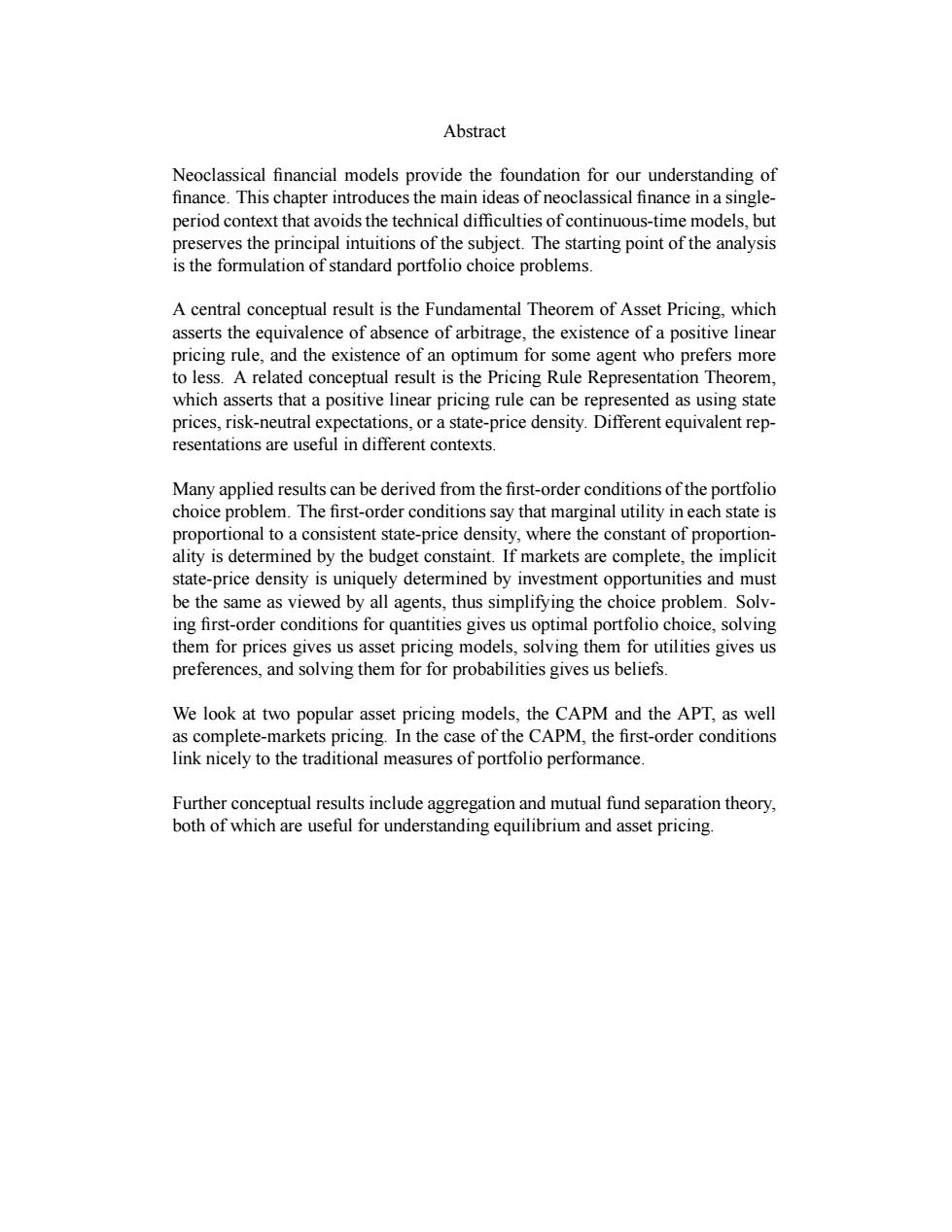正在加载图片...

Abstract Neoclassical financial models provide the foundation for our understanding of finance.This chapter introduces the main ideas of neoclassical finance in a single- period context that avoids the technical difficulties of continuous-time models,but preserves the principal intuitions of the subject.The starting point of the analysis is the formulation of standard portfolio choice problems. A central conceptual result is the Fundamental Theorem of Asset Pricing,which asserts the equivalence of absence of arbitrage,the existence of a positive linear pricing rule,and the existence of an optimum for some agent who prefers more to less.A related conceptual result is the Pricing Rule Representation Theorem, which asserts that a positive linear pricing rule can be represented as using state prices,risk-neutral expectations,or a state-price density.Different equivalent rep- resentations are useful in different contexts. Many applied results can be derived from the first-order conditions of the portfolio choice problem.The first-order conditions say that marginal utility in each state is proportional to a consistent state-price density,where the constant of proportion- ality is determined by the budget constaint.If markets are complete,the implicit state-price density is uniquely determined by investment opportunities and must be the same as viewed by all agents,thus simplifying the choice problem.Solv- ing first-order conditions for quantities gives us optimal portfolio choice,solving them for prices gives us asset pricing models,solving them for utilities gives us preferences,and solving them for for probabilities gives us beliefs. We look at two popular asset pricing models,the CAPM and the APT,as well as complete-markets pricing.In the case of the CAPM,the first-order conditions link nicely to the traditional measures of portfolio performance. Further conceptual results include aggregation and mutual fund separation theory, both of which are useful for understanding equilibrium and asset pricing.Abstract Neoclassical financial models provide the foundation for our understanding of finance. This chapter introduces the main ideas of neoclassical finance in a singleperiod context that avoids the technical difficulties of continuous-time models, but preserves the principal intuitions of the subject. The starting point of the analysis is the formulation of standard portfolio choice problems. A central conceptual result is the Fundamental Theorem of Asset Pricing, which asserts the equivalence of absence of arbitrage, the existence of a positive linear pricing rule, and the existence of an optimum for some agent who prefers more to less. A related conceptual result is the Pricing Rule Representation Theorem, which asserts that a positive linear pricing rule can be represented as using state prices, risk-neutral expectations, or a state-price density. Different equivalent representations are useful in different contexts. Many applied results can be derived from the first-order conditions of the portfolio choice problem. The first-order conditions say that marginal utility in each state is proportional to a consistent state-price density, where the constant of proportionality is determined by the budget constaint. If markets are complete, the implicit state-price density is uniquely determined by investment opportunities and must be the same as viewed by all agents, thus simplifying the choice problem. Solving first-order conditions for quantities gives us optimal portfolio choice, solving them for prices gives us asset pricing models, solving them for utilities gives us preferences, and solving them for for probabilities gives us beliefs. We look at two popular asset pricing models, the CAPM and the APT, as well as complete-markets pricing. In the case of the CAPM, the first-order conditions link nicely to the traditional measures of portfolio performance. Further conceptual results include aggregation and mutual fund separation theory, both of which are useful for understanding equilibrium and asset pricing